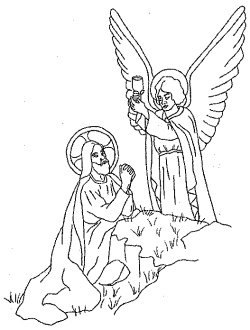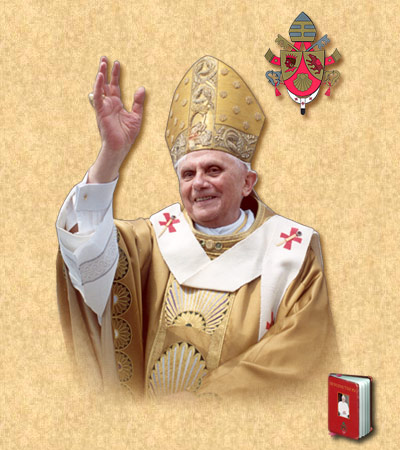 Part of Archbishop Fulton J. Sheen’s spiritual life was a daily Holy Hour. It was the story of a little Chinese girl which inspired Archbishop Sheen to make a daily Holy Hour. As the story goes, she was an eleven year old Chinese girl who went unnoticed in the back of a church at prayer when the Communists came and arrested the priest and held him captive in his own rectory. In the church building the Communists entered the sanctuary, broke the Tabernacle, took the ciborium and threw it on the floor causing all the Eucharistic Hosts to be scattered on the floor. Once the Communists did their damage that night, the little girl, night after night, returned to that church to make a Holy Hour, and did so very quietly so as to remain undetected by the guard at the rectory. She concluded each Holy Hour by bending over to pick up a Eucharistic Host off the floor with her tongue and thus receive Jesus in the Blessed Sacrament. She did this every night until there were no longer any Hosts on the floor. On that last night, however, a noise she made alerted the guard who chased her, caught her and mercilessly beat her to death. The priest witnessed her martyrdom from his bedroom window at the rectory. Archbishop Sheen made a promise to God that he would make a daily Holy Hour because of the inspiration this story gave him. Here are some inspiring words from Archbishop Fulton J. Sheen:
Part of Archbishop Fulton J. Sheen’s spiritual life was a daily Holy Hour. It was the story of a little Chinese girl which inspired Archbishop Sheen to make a daily Holy Hour. As the story goes, she was an eleven year old Chinese girl who went unnoticed in the back of a church at prayer when the Communists came and arrested the priest and held him captive in his own rectory. In the church building the Communists entered the sanctuary, broke the Tabernacle, took the ciborium and threw it on the floor causing all the Eucharistic Hosts to be scattered on the floor. Once the Communists did their damage that night, the little girl, night after night, returned to that church to make a Holy Hour, and did so very quietly so as to remain undetected by the guard at the rectory. She concluded each Holy Hour by bending over to pick up a Eucharistic Host off the floor with her tongue and thus receive Jesus in the Blessed Sacrament. She did this every night until there were no longer any Hosts on the floor. On that last night, however, a noise she made alerted the guard who chased her, caught her and mercilessly beat her to death. The priest witnessed her martyrdom from his bedroom window at the rectory. Archbishop Sheen made a promise to God that he would make a daily Holy Hour because of the inspiration this story gave him. Here are some inspiring words from Archbishop Fulton J. Sheen:The moment of communion is that special intimacy reserved to real lovers. There are three intimacies in life: hearing, speaking, and touching. Our first contact with anyone who loves us is to hear his voice, our second is to see him, the third -- and this is reserved only for intimates -- is the privilege of touch. We hear of Christ in the Scriptures, we see Him by the eyes of faith, but we touch Him in the Eucharist. He only asks that we should purge our consciences of sin and come to Him, ready to receive what He wants to give us for He knows that we need Him.
Holy Communion is incorporation not only to the life of Christ, but also to His death. To save our souls, the life of Christ must be duplicated in our own life. What He did in His birth, at Calvary, in His Resurrection, and Ascension, we must do. But we cannot enter into those heavenly blessings except through the touch of the Cross, namely, through penance, mortification, and self-denial, and a death to our egotism.
The Eucharist is not only a sacrament of life, but also the sacrament of mortification. Only when we are stamped with the Sign of the Cross will we be stamped with the glory of His Resurrection. The dying Christ is continually at work . . . urging us to represent it in our detachment from the seven pallbearers of the soul -- the seven capital sins.
The Blessed Sacrament is present in the Tabernacle day and night. There Christ dwells, Body, Blood, Soul, and Divinity, under the sacramental appearances of bread. How do we know it? Because Christ told us so! Is there any other fundamental evidence? None other than that; but is there any other reason in the world as strong as the Word of God Himself? Hence, the Eucharist is above all other sacraments -- it is the sacrament of faith.
The faithful believe that Christ is as really and truly present sacramentally in the Tabernacle as you are present while you read this. It is this that makes the Church different from any other building. Not a pulpit, not an organ, not a choir, but Christ is the centre. As the tabernacle was the centre of worship in the Old Testament, so the tabernacle and the altar are the centre of worship in the New Testament.
Visitors to the Church say they ‘feel the difference’, though they know nothing about the Eucharist, as they might feel heat and know not the nature of fire. But to the faithful members of Christ's Mystical Body, here is Christ! Before His Eucharistic presence, the downcast eyes of sin find wealth of purging tears; here the heart wounded by betraying loves breaks its silence to the invitation of the Living Saviour: ‘Child, give Me thy heart’. Here the knee is humbled in genuflection and the heart exalted in adoration; here priests make their ‘Holy Hour’ in answer to the invitation of their Lord in the Garden. Here is the trysting place of love, for this is the ‘bread which is come down from heaven’ (Saint John 6:41-42) and will remain with us ‘unto the consummation of the world’ (Saint Matthew 28:20). Here Emmaus lives again as His disciples recognize Him in the breaking of the bread.





